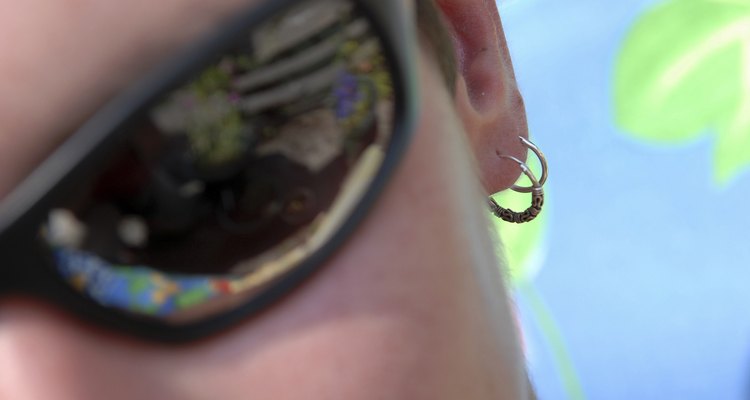
Ingram Publishing/Ingram Publishing/Getty Images
Look beyond your lobes and you'll discover that there are several, more daring places you can pierce your ears. Whether you're looking for a demure stud you can wear to work or a large, statement earring to get you noticed at night, discover all the unexpected places on your ear that can be adorned and whether or not these types of piercings are right for you.
Tragus
The middle of your ear hosts the tragus piercing. The tragus piercing is located in the small flap of skin that sticks out from the face and is in front of the ear canal opening. When cleaning your ears with a cotton swab, the tragus moves. Not everyone is suited for a tragus piercing. If the tragus too small or thin, the chances of migration are high. Migration occurs when the jewelry moves away from the original piercing site. It may come to rest and stop or result in the skin splitting, pushing out the earring completely. A tragus piercing is more prone to migration when there is not enough space in between the piercing hole and the tip of the tragus, causing the body to reject the jewelry. Professional piercers will always alert you if your anatomy is inappropriate for a tragus piercing, and inform you of other options.
The tragus is pierced with a 16-gauge needle and jewelry. Jewelry appropriate for an initial tragus piercing includes captive bead rings and flat back labrets. For healed tragus piercings, circular barbells, nostril screws and curved barbells are other options.
Conch
The conch piercing is located in the center of the ear, across from the ear canal. If you have a large ear, or a considerable amount of space in the center of your ear, several conch piercings are possible. A conch piercing is in the thickest part of the ear, named the concha, and has the least amount of risk for migration of all the ear cartilage piercings. A conch piercing has a low risk for migration due to the location, for the piercing is not along the edge of the ear and the skin is thick.
The initial jewelry for a conch piercing is a captive bead ring or a barbell. You may prefer to start with a barbell because the diameter of a captive bead ring for an initial conch piercing is 5/8 inch and intimidating. Conch piercings are pierced at larger gauges, such as 10 or 12. Placing small-gauge jewelry in the thick ear cartilage where the conch is located could cause cuts inside the piercing channel, with the jewelry acting as a cheese cutter while moving. After healing, conch piercings can be flat back labrets, plugs or circular barbells.
Industrial
An industrial piercing is two piercings with one long piece of jewelry. Two separate pieces of jewelry, commonly 14 gauge, are another option. The industrial piercing is located on the top of the ear, with two parts of the helix pierced. After piercing the first helix, the piercer inserts one half of the barbell into the first helix; after piercing the second helix, he inserts the other half.
Industrial piercings are prone to migration if the lip of the helix is not pronounced or if it's exposed to continuous pressure. The weight of the barbell on a small lip of the helix causes the jewelry to migrate because the helix is not strong enough to support the jewelry. Hypertrophic scarring is common if the piercing is performed at an incorrect angle. Hypertrophic scars are temporary bumps around the piercing hole that will shrink or fade completely with treatment, changing the jewelry or relieving pressure from the piercing. Professional piercers recommend waiting for a cartilage piercing in one ear to heal before getting your other ear pierced. Ear cartilage piercings take six months to one year to heal. Only an experienced, professional piercer should perform an industrial piercing.
Related Articles

How to Put in Double Flare Ear Plugs

How to Gauge Your Ears Without Tapers

Types of Piercing Needles

How Do They Pierce Your Ears With ...

How to Stretch Ears With Tape

How Long Do I Have to Wait to Change My ...

What Type of Rings Can You Get When You ...

Problems With Nose Piercings
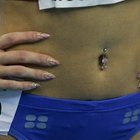
How Do You Take Hoop Belly Button Rings ...
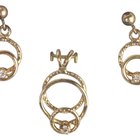
How Long After Piercing Can You Change ...

Why Do People Pierce Their Ears?

Facts on Nose Piercings

How to Gauge the Ears Right After the ...

What If They Make a Mistake When ...
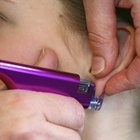
What Size Gauge Is an Ear Piercing Gun?
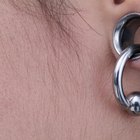
Ear Gauge Problems

How to Remove a Labret Piercing

What to Do When a Nose Ring Falls Out

How to Take Out a Lip Ring Stud
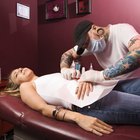
The Scale of Pain for Piercings
References
Writer Bio
Maude Coffey retired after 10 years working as a professional body modification artist in the tattoo industry. She is certified in principles of infection control and blood-borne pathogens. Coffey received additional training and classes, such as anatomy, jewelry standards and aftercare, from the Association of Professional Piercers. Coffey aims to educate about safe tattooing and piercing practices while writing for various websites.
Photo Credits
Ingram Publishing/Ingram Publishing/Getty Images